Intel Core 2 CULV Roundup: Who Needs Atom?
by Jarred Walton on February 4, 2010 4:00 AM ESTBlending Battery Life with Performance
We just showed how CULV skunks Atom when it comes to performance. Dual-core Atom 330 is still quite a bit slower, and it's not even close when we look at the mobile Atom CPUs. This is all from a relatively "weak" 1.3GHz Core 2 processor. But Atom CPUs have a TDP of just 2.5W for N280 and 5.5W for N450 (the latter also includes the chipset, so it actually uses less power than N280 + 945GSE); meanwhile, CULV is listed as having a TDP of 10W. Advantage: Atom, right? Well, not so fast. The newer Pine Trail platform definitely helps, with a much lower power draw from the chipset and graphics. Max TDP doesn't necessarily correlate well to idle or low use TDP, though, which is where most users tend to operate their PCs. Here's how battery life stacks up.
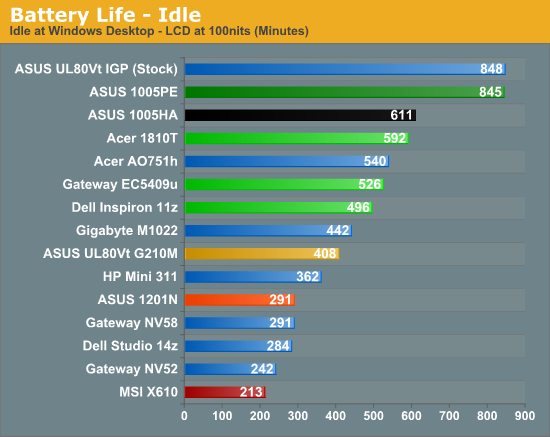
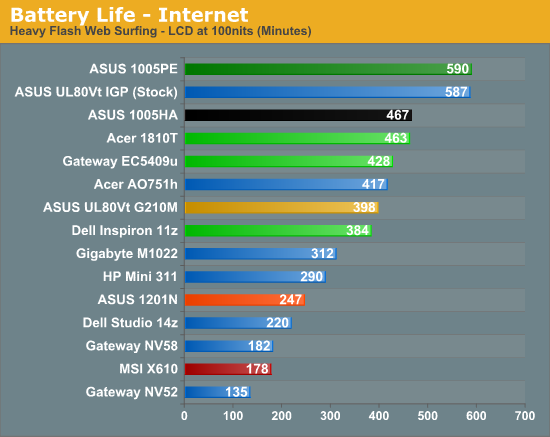
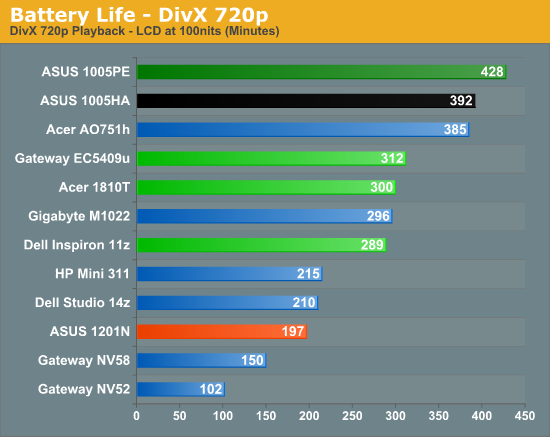
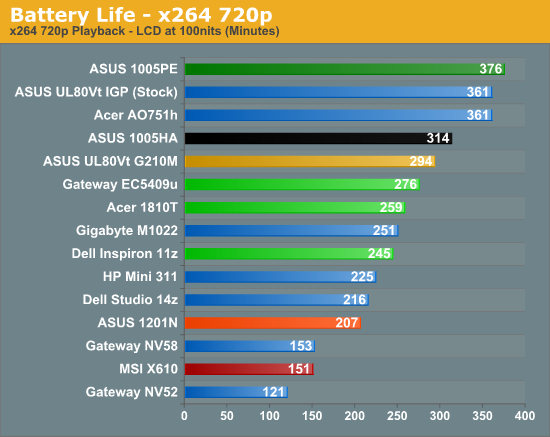
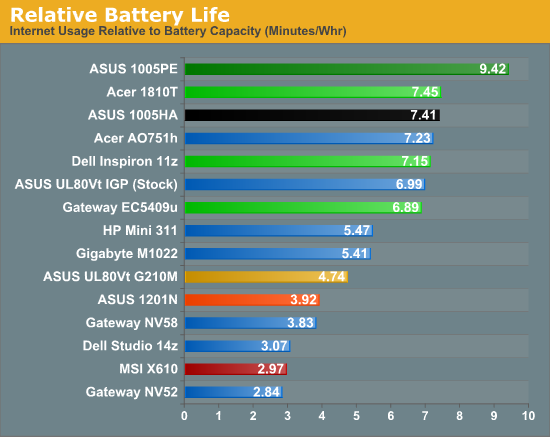
We gained performance but we do give up a bit in battery life - at least when we look at Pine Trail. The smaller CULV laptops like the Acer AS1810T are able to come very close to Atom N280 battery life in the Idle and Internet tests, while the video playback results still favor N280 (provided you're not trying to do 1080p H.264). Atom N450 on the other hand manages to boost battery life by anywhere from 10% (DivX) to 40% (Idle), putting it out of reach of CULV when both are using similar capacity batteries.
The AS1810T delivers an impressive result in our Heavy Internet Browsing test, coming in just shy of eight hours at 463 minutes. That's a virtual tie with the older Atom N280 based ASUS 1005HA (467 minutes), indicating CULV is able to render the web pages and get to a deep sleep state faster than N280. The newer ASUS 1005PE Pine Trail netbook still bests the AS1810T by just over two hours (590 minutes), so if you want maximum battery life Atom continues to beat the other Intel processors. The other CULV options both trail the AS1810T, which is expected. The EC5409u is larger and so the LCD will draw more power, while the Dell 11z has a slightly lower capacity battery.
In terms of relative battery life (and of course, we should note that we're going off the advertised battery capacities, which may be slightly off), the CULV and most N280 offerings are clustered tightly together. While the EC5409u does use more power, the DDR3 memory appears to mitigate that somewhat, with overall battery life still very close to the smaller laptops. Pine Trail is at its best in Idle battery life, but the Internet test is another strong point: it gets 25% more battery life compared to CULV for the same battery capacity.
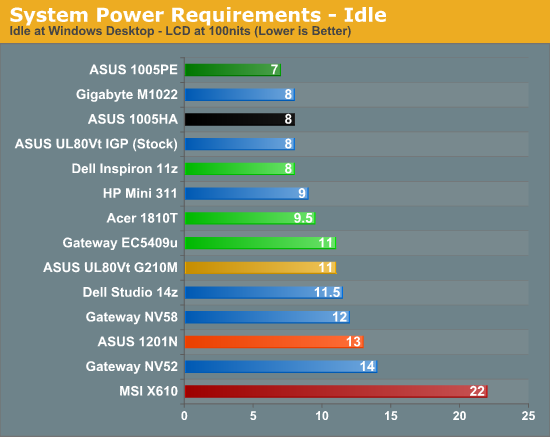
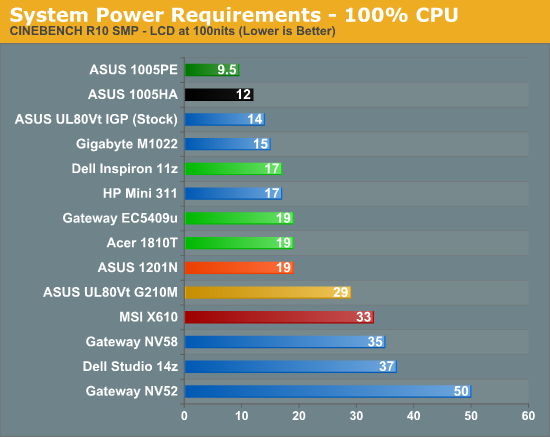
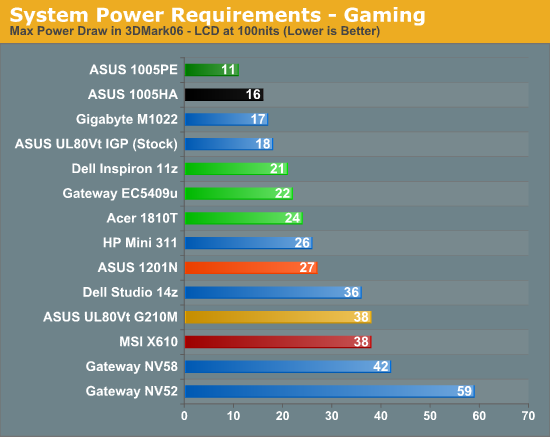
Looking at power requirements helps clear up any lingering questions. Mobile Atom CPUs are designed to sip power, with their highest load sucking down around 4W for N450 and 7W for N280 (including chipset power draw). We estimate that at idle, Atom N280 uses 1W, the chipset probably uses 2W, LCD gets 3W, and the remainder is divvied up among the other bits and pieces. Atom N450 can cut another 1W from Idle power requirements, which is at least a 15% reduction (and possibly more, given our tools are only accurate to at best .5W). In contrast, a CULV CPU can idle very well, but under load the power draw jumps significantly. The AS1810T looks like it uses every bit of its 10W max TDP. Add on graphics and the gap widens even more, though here we need to mention that GMA 950/3150 are a very big step down from GMA 4500MHD (which is another big step back from something like GeForce 9400M).
Overall, it appears that CULV processors are very similar in terms of idle power requirements when compared to Atom N280, especially once we factor in chipsets. As we mentioned above, in many situations an application will need to do a set amount of work as quickly as possible (e.g. rendering a web page), after which the CPU can go into a deep sleep state. The faster the work gets done, the sooner the CPU can sleep, and the net result is that even in moderate loads CULV can compete quite well against N280. The catch is that there are other loads (like video decoding) where CULV ends up using quite a bit more power than Atom, but in common usage scenarios the battery life is still very good.










62 Comments
View All Comments
tno - Friday, February 5, 2010 - link
Jarred,Again, I am not writing to instill any ill will. But technical content is only half of the product. Grammar and style are not mutually exclusive, and the proof of this is the use of style guides like the MLA, or Strunk and White, or even that of fellow online publication Engadget. These guides do more than just tell you where to use a comma; they seek to elevate and standardize the quality of writing for a publication.
Now I am all for introducing personal style to an article. And I am always impressed with the technical fidelity and content of AT writing. AT articles are more than just spec sheets and test results; they are pieces of writing. Arguing that omission of the preposition connecting two nouns is a matter of style is ignoring proper grammar with no gain. It is inexcusable for the writing component of any AT articles to be neglected, even if the technical content is of a high caliber.
Again, I am not trying to cause you any grief, nor imply that your writing is insufficient for inclusion on AT. I am simply pointing out that a small amount of editing and proofreading could go along way to improve all of AT's coverage.
I believe that this discussion has probably moved beyond the scope of the comments section and invite you to look-up my email through the forums if you would like to continue discussing this.
tno
JarredWalton - Friday, February 5, 2010 - link
Sadly (I suppose) I'm usually the one doing editing of other articles. It's much more difficult to edit your own content, especially after you've been over it ten times in the process of writing.But seriously, I find it astonishing that out of all the articles written on AnandTech and all the mistakes present in said articles, you would choose to complain about something so innocuous as "A couple years back" vs. "A couple of years back". We could also rephrase it "Just over two years ago" and it would be correct. I suppose http://www.thefreedictionary.com/couple">I'm in the minority when dropping the "of", though again I prefer to stick with informal styles for the most part.
At least we're not having a discussion about my use of "everything but" vs. "everything except"... or was that you as well? LOL
aapocketz - Thursday, February 4, 2010 - link
Back when the macbook Air came out these CULV processor laptops were $2000+, now they have dropped in price and could cannibalize high end netbooks. They are even being confused with netbooks now; consider the new Alienware m11x keeps being called a netbook, even though it uses a CULV.I have had similar thoughts, and almost purchased a Thinkpad x301 recently for under $800. The only reason I held back was I know these CULV chips are a couple years old now, and there are new I5 and I7 chips coming out soon, forcing prices down even further. When the Core2 CULV ultralights are sub $500, why buy these (bloated) netbooks for similar price? Netbooks originally were supposed to be around $200 or less though.
Also these ultralights have a few more little perks than the netbooks have, like backlit keys (or a "thinklight") - there is not a single netbook with a backlit keyboard.
Shadowmaster625 - Thursday, February 4, 2010 - link
Why dont you compare the $400 CULV notebooks with the netbooks, since that is the direct competition? Also there should be a Sempron M100 in here somewhere.macs - Thursday, February 4, 2010 - link
What about arrandale ULV? Asus UL30JT is coming soon and he brings core I7-620 ULV and NVIDIA 310M GPU. Should be great!I want something better than my atom netbook, maybe with a 11.6" screen but I want to wait those new Nehalem ULV...
Visual - Thursday, February 4, 2010 - link
I would love to see also the Acer 1420P / 1820P variants - no need to explore their tablet functionality in this comparison as it is off-topic, but do compare their keyboards, build quality and especially screen quality to the other non-touchscreen options. I've always wondered if touchscreen panels have a noticeably different visual quality.Also, if I understand correctly all these "current" CULVs are old Core 2/Penryn based, and as such are already old tech despite being launched in the products that you view only very recently. Shouldn't they get replaced with new Nehalem-generation 32nm processors any time soon? Or am I misunderstanding something?
Intel's code names and roadmaps are making my head hurt right now, so I'd really like to know your say on the matter - is there something in the same segment that is worth waiting for on the horizon?
QuietOC - Thursday, February 4, 2010 - link
The CULVs are all "old" 45nm Penyrn-3M/Wolfdale-3M 82 mm² dies--same core as the desktop E3x0 Celerons, E5x0/E6x0 Pentium Dual Cores, and E7x0 Core 2 Duos. The significant difference is that the CULV SpeedStep goes down to a 4x CPU multiplier during idle, my desktop Wolfdale-3Ms only go down to 6x. The Atom N270 also only goes down to a 6x multiplier.JarredWalton - Thursday, February 4, 2010 - link
Arrandale ULV parts have been announced, but nothing has shipped yet. I'm hoping to get one some time in the next month or two. One thing with the Arrandale ULVs is that they have a TDP of 18W compared to 10W. Obviously part of that is the integration of the new IGP, but there's definitely a question of how low their idle power draw can go. I suspect the initial Arrandale ULV parts will use slightly more power than the current Penryn parts.Performance is the other question we'll need to answer. Price wise, the newer Arrandale ULV chips run at a stock speed that's slightly lower than SU4100/SU7300 (1.06GHz and 1.20GHz for the http://www.anandtech.com/mobile/showdoc.aspx?i=370...">latest chips), and they also cost quite a bit more than SU4100. But yes, I am very interested to get some new ULV parts for review.
GTaudiophile - Thursday, February 4, 2010 - link
Anand,Out of curiosity, why not compare with the AMD Turion / Neo / X2 processors by chance?
OMG Snarf - Thursday, February 4, 2010 - link
I've got to agree with this. For the price point of the systems being benched, you can pick up an Athlon Neo X2 for $500, or a Turion Neo X2 for $600, direct from Toshiba with no shipping. Obviously the battery life won't be as good compared to the Intel CULVs, but I would be curious to see how the 12cell stacks up too. With the added $150 cost of the battery, you hit the same costs as the Intel CULV systems ($650), but get a Radeon 3200 instead of the anemic Intel 4500.